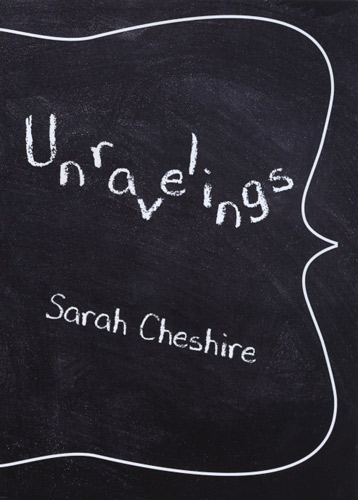Unravelings
Sarah Cheshire’s Unravelings is exactly the kind of book you never want to read again. As fiction based on facts, there’s a fine line between being able to accept the story as not true, and being wholly disturbed by what parts of it may very well be true. Sadly, the premise is one that has been around since I was in college, and since generations before mine: female student is enamored by male professor, engages in flirtations, perhaps falls in love, all while others—including professional colleagues of said professor—see what is happening and do nothing. Could they have? Should they have? I can’t help but wonder where responsibility lies in these situations, and Cheshire offers no answer either.
Sarah Cheshire’s Unravelings is exactly the kind of book you never want to read again. As fiction based on facts, there’s a fine line between being able to accept the story as not true, and being wholly disturbed by what parts of it may very well be true. Sadly, the premise is one that has been around since I was in college, and since generations before mine: female student is enamored by male professor, engages in flirtations, perhaps falls in love, all while others—including professional colleagues of said professor—see what is happening and do nothing. Could they have? Should they have? I can’t help but wonder where responsibility lies in these situations, and Cheshire offers no answer either.
Cheshire’s “short nonlinear memoir” won the 2017 Etchings Press Chapbook Contest. She writes, “In it, I attempt to recreate a Title IX procedure I was involved in while in college, touching on themes related to memory, gender based trauma and emotional gaslighting.” This would not make me want to read the book. Since I work in higher ed, and we are inundated with Title IX trainings and policy updates, the last thing I want to read is the story of (yet another) victim of bad behavior harbored behind university doors. Instead, it was Cheshire’s “Prologue: Storytelling as Grey Matter” that drew me in:
In crafting this narrative, my intention is not to seek retribution or cast blame, but to delve into the intricate psychological landscape of a relationship imbued in both intimate creative energy and deep power imbalance. . . how we as storytellers construct and reconstruct truth through narrative, and the ways in which accountability can become complicated through our manipulations of memory, both those advertent and those inadvertent.
Cheshire’s narrative skips around from the narrator’s interview with the Title IX officer to events with the professor, mingled with other events from her memory. In an early scene, groped by a man in a bar, the narrator reacts by shoving him—forcefully—and then, recognizes her own breaking point:
Suddenly, this is no longer about the asshole sprawled out across the table in front of me, clutching his wrist and groaning. It is not just about this one grope. It is about all the unwanted touches, which are now surfacing from underneath my skin with a force almost beyond my control. It is about the acute feeling that I don’t really exist; that I am just a construction of unwanted touches; a molding of the places Their Hands have grasped. I am unwanted touch upon unwanted touch upon unwanted touch upon hands upon hands upon cold, clammy hands—
From here, the narrator skips to “His kitchen.” She is touching him and then assesses her memory, “Did he initiate the kiss or did I?” Recounting the secrecy of their meetings, trying to discern whether she was ‘crazy’ to perceive his responses as relationship-building or if there was truly a burgeoning love between them. The “He, Him, His” in the story is an unnamed professor of creative writing, referred to as B.M. and also Professor X. in the fictionalized Title IX report excerpts.
The storyline reveals that Professor X. was about to leave the college “due to the limited terms of his teaching fellowship.” Students who learned of this started a movement to petition the university to provide Professor X. with a tenure track position, and it is our narrator who is one of the lead students in this movement. She is referred to as Jane Doe in the Title IX notes. There is also a Professor E., chair of the English department, who draws Doe into private conversations with Professor X. off campus to discuss the petition and the relationships between colleagues, and provide Doe with information that will help with the efforts to retain Professor X.
How many flags of inappropriateness are now flying? Continuing to read Cheshire’s narrative, the rising discomfort with each disclosure of the professors’ behaviors is inescapable. Professor E. sends Doe confidential information via Facebook messenger and advises Doe on how to evade the university administration. Cheshire includes realistic (are they real?) images of e-mail and text messages with names crossed out in red—a nice touch rather than the standard black censor line. These pieces are noted in brackets as “[Collection of Evidence]”—once again blurring the line between fact and fiction.
Doe asks Professor X. to advise her senior creative writing thesis, which further complicates their relationship. They are seeing/not seeing each other, touching/not touching one another, intimate/not intimate—is there a relationship, or is Doe “crazy”? Professor X. disappears for periods of time, causing Doe anxiety. He doesn’t respond to her texts, and then when he finally does, brushes it off as if it were nothing more than, “. . . just working on writing. writing writing writing. All else will happen, but I must live in craft. How are you?” And with that, he pulls Doe back into believing he cares about her.
On a visit to his house, after Professor X. has used asked Doe for a ride to DMV to get his driver’s license, he offers her dinner and beers to thank her, and they “allegedly end up ‘kissing and such’ for an extended period of time in Professor X.’s kitchen.” But, then, similarly to how they had once ‘taken backroads to go to dive bar outside of town,’ and on a midnight walk “subconsciously gravitated into the shadows of academic buildings,” Professor X. asks Doe “to temporarily leave his house because ‘Professor O. [of the Sociology Department] is supposed to stop by.’” She does so, only to return later to be used again as a chauffeur to give Professor X. a ride to the airport.
It is after Professor X.’s absence to visit his home country that their relationship roller coasters. It is heart-wrenching to read Doe’s account of working on her final thesis, the research, the public presentation of her work, and her continued attempts to reach out to Professor X., get his involvement in her work, to show up for the presentation—only to be ignored and put off with multiple excuses. At the same time, he is sending “series of ‘flattering’ text messages [ . . . ] highlighting his ‘profound care’ for her, her work, and her presence in his life.” All the while, Professor E. communicates with Doe to be cautious, especially with “‘anything involving Professor X.’” Doe’s “paranoia” through all of this—of the administration, of Professor X.’s commitment/not commitment to her—only increases.
And then—the tenure track position is opened. Others inform Doe about it, and she is surprised not to have heard about it from Professor X. She congratulates him in a text and asks why he didn’t tell her. He responds, “I have no knowledge of the things you are talking about and I would encourage you not to make note of this to anyone.” Doe says she feels “‘Jedi Mind-Tricked.’” He adds, “Continue studying and enjoying your senior year, and try not to think or talk about these matters.” Doe asks for clarification and is told, “I am very very busy with class prep tonight and tomorrow but don’t think too much about this. It is nothing you should be concerning yourself with; you have done good work.” Doe asks for clarification and gets no response.
But wait, there’s more. Professor X. does meet with Doe, tells her he has “’enemies in the college’” who “will find ways to undermine his newly created tenure track position” and more about his visa renewal from which he wanted to “’spare her the drama.’” And they meet/don’t meet, Professor X. disappears for chunks of time, reappears and professes/doesn’t profess having feelings for Doe, until what appears to be their final interaction, in the college quad. Professor X. approaches Doe to tell her that she will be receiving an A- grade rather than an A+ for lack of a final reflection paper that was not turned in.
After graduation, Doe “inadvertently” revealed information to a dean about her relationship with Professor X. Specifically, it seems, her having been in his kitchen that one night, which is what prompted the investigation. It is where the narrative began, and where it ends, with Doe insisting she doesn’t want anyone to get into trouble. She tentatively goes forward with the investigation (the dean was obligated to report):
I didn’t want to punish him. To punish him would be to punish myself: I wanted to be there just as much as he did, right?
I just wanted resolve. Reconciliation. Maybe even a rekindling of something. What he called restorative justice. A tighter ending; not the one in which I stand gaping on the campus quad days before graduation, as he walks away.
Her hope that their stories would converge in the reporting, her hope for any reconciliation, her hope for validation of their relationship, of her not being “crazy,” are denied in his single sentence testimony, “I know nothing of the stories she is telling.” And this is all Doe is left with to finalize her experience with infatuation, love, her efforts for a cause, her undergraduate creative writing experience, her having been brought into the lives of university faculty and administration, and ultimately, her release from it all.
The non-linear narrative style portrays precisely how disjointed the character felt throughout her ordeal, how these situations play out in real life, and how they sound upon trying to explain them to others. Cheshire is deft in her handling of such a complex narrative, reflecting through her rhetoric how deep emotional pain can be built, experience by experience, layer upon layer. While complicated, it is never confusing; while convoluted, it is at once exceedingly clear.
Doe’s story—and what of it may have been true from Cheshire’s own life—is one that plays on repeat year after year on college campuses. Perhaps the story we don’t want to hear anymore is exactly the one we need to hear again, because it persists. Cheshire may have said her writing does not mean to place blame, but it’s not hers to place. Let the reader decide? True enough for the fiction, but also, let the people who live(d) these lives decide. There is blame. And it would be good to see it placed squarely where it belongs in an effort to end this cycle, and end these stories for good.





